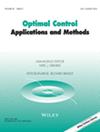Linear quadratic self-tuning control of a liquid-liquid extraction column
IF 1.5
4区 计算机科学
Q3 AUTOMATION & CONTROL SYSTEMS
引用次数: 1
Abstract
An application of a linear quadratic self-tuning control approach to a pulsed liquid-liquid extraction column is described. The control algorithm is derived from the minimization of a quadratic cost function. The resulting Riccati equation is iterated until the closed-loop poles belong to a predefined stability domain included in the unit circle. Based upon the certainty equivalence principle, the adaptive control algorithm involves a parameter identification procedure and a feedback control law which uses the estimated parameters. Several experiments are carried out on a pulsed liquid-liquid extraction column. Such extractors are being increasingly used in several industries because they are not energy-consuming and they lead to high product purity. The column considered has the same dimensions as those currently used in fine chemical processes. The control objective is to optimize the column behaviour. The selected control variables are the pulse frequency and the conductivity measured at the bottom of the column. The experiments have been carried out with a mixture of water and toluene. The physical model developed for the column is too complex to use for control purposes. To represent the complex behaviour of the column, a single-input/single-output discrete-time linear model was adopted. The parameters in the model are estimated on-line with normalized data. The forgetting factor is also adjusted to maintain a constant trace of the estimator gain matix. The results obtained show the ability of this algorithm to improve the efficiency of the process considered. Finally, some details on practical implementation are provided.液液萃取塔的线性二次自整定控制
介绍了一种线性二次自整定控制方法在脉冲液液萃取柱中的应用。控制算法是由一个二次代价函数的最小化推导而来的。迭代得到的Riccati方程,直到闭环极点属于包含在单位圆中的预定义稳定域。基于确定性等效原理,自适应控制算法包括参数辨识过程和利用估计参数的反馈控制律。在脉冲液-液萃取柱上进行了实验研究。由于这种萃取剂不消耗能源,而且产品纯度高,因此在一些工业中得到越来越多的应用。所考虑的柱具有与目前在精细化学过程中使用的柱相同的尺寸。控制目标是优化柱的行为。所选择的控制变量是脉冲频率和电导率测量在柱的底部。实验是用水和甲苯的混合物进行的。为色谱柱开发的物理模型过于复杂,无法用于控制目的。为了表示柱的复杂行为,采用单输入/单输出离散时间线性模型。利用归一化数据在线估计模型中的参数。遗忘因子也被调整以保持估计器增益矩阵的恒定跟踪。结果表明,该算法能够提高所考虑过程的效率。最后,给出了具体的实现方法。
本文章由计算机程序翻译,如有差异,请以英文原文为准。
求助全文
约1分钟内获得全文
求助全文
来源期刊

Optimal Control Applications & Methods
工程技术-应用数学
CiteScore
3.90
自引率
11.10%
发文量
108
审稿时长
3 months
期刊介绍:
Optimal Control Applications & Methods provides a forum for papers on the full range of optimal and optimization based control theory and related control design methods. The aim is to encourage new developments in control theory and design methodologies that will lead to real advances in control applications. Papers are also encouraged on the development, comparison and testing of computational algorithms for solving optimal control and optimization problems. The scope also includes papers on optimal estimation and filtering methods which have control related applications. Finally, it will provide a focus for interesting optimal control design studies and report real applications experience covering problems in implementation and robustness.
 求助内容:
求助内容: 应助结果提醒方式:
应助结果提醒方式:


